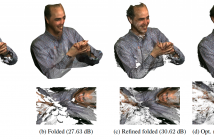
Existing techniques to compress point cloud attributes leverage either geometric or video-based compression tools. We explore a radically different approach inspired by recent advances in point cloud representation learning. Point clouds can be interpreted as 2D manifolds in 3D space. Specifically, we fold a 2D grid onto a point cloud and we map attributes from the point cloud onto the folded 2D grid using a novel optimized mapping method. This mapping results in an image, which opens a way to apply existing image processing techniques on point cloud attributes.
- Categories:
 20 Views
20 Views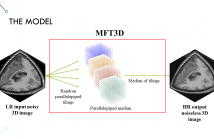
- Read more about Super-resolution of 3D MRI corrupted by heavy noise with the Median Filter Transform
- Log in to post comments
The acquisition of 3D MRIs is adversely affected by many degrading factors including low spatial resolution and noise. Image enhancement techniques are commonplace, but there are few proposals that address the increase of the spatial resolution and noise removal at the same time. An algorithm to address this vital need is proposed in this presented work. The proposal tiles the 3D image space into parallelepipeds, so that a median filter is applied in each parallelepiped. The results obtained from several such tilings are then combined by a subsequent median computation.
- Categories:
 18 Views
18 Views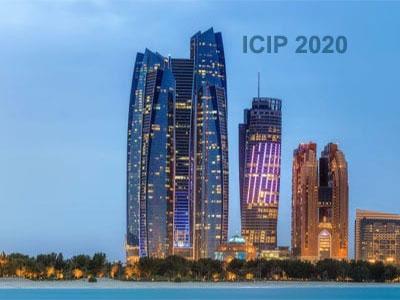
- Read more about NOVEL VIEW SYNTHESIS WITH SKIP CONNECTIONS
- Log in to post comments
Novel view synthesis is the task of synthesizing an image of an object at an arbitrary viewpoint given one or a few views of the object. The output image of novel view synthesis exhibits a significant structural change from the input. Because of the large change, the skip connections or U-Net architecture, which can sustain the multi-level characteristics of the input images, cannot be directly utilized for the novel view synthesis. In this paper, we investigate several variations of skip connection on two widely used novel view synthesis modules, pixel generation and flow prediction.
- Categories:
 30 Views
30 Views

- Read more about 3D OBJECT DETECTION USING TEMPORAL LIDAR DATA
- Log in to post comments
- Categories:
 57 Views
57 Views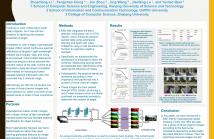
- Read more about A BAND ATTENTION AWARE ENSEMBLE NETWORK FOR HYPERSPECTRAL OBJECT TRACKING
- Log in to post comments
Hyperspectral videos contain images with a large number of light wavelength indexed bands that can facilitate material
identification for object tracking. Most hyperspectral trackers use hand-crafted features rather than deep learning gener-
ated features for image representation due to limited training samples. To fill this gap, this paper introduces a band atten-
tion aware ensemble network (BAE-Net) for deep hyperspectral object tracking, which takes advantages of deep models
- Categories:
 20 Views
20 Views
- Read more about EMPIRICAL ANALYSIS OF OVERFITTING AND MODE DROP IN GAN TRAINING
- Log in to post comments
We examine two key questions in GAN training, namely overfitting and mode drop, from an empirical perspective. We show that when stochasticity is removed from the training procedure, GANs can overfit and exhibit almost no mode drop. Our results shed light on important characteristics of the GAN training procedure. They also provide evidence against prevailing intuitions that GANs do not memorize the training set, and that mode dropping is mainly due to properties of the GAN objective rather than how it is optimized during training.
- Categories:
 8 Views
8 Views
- Read more about EMOTION TRANSFORMATION FEATURE: NOVEL FEATURE FOR DECEPTION DETECTION IN VIDEOS
- Log in to post comments
Deception detection has been a hot research topic in many areas such as jurisprudence, law enforcement, business, and computer vision. However, there are still many problems that are worth more investigation. One of the major challenges is the data scarcity problem. So far, only one multi-modal benchmark dataset on deception detection has been published, which contains 121 video clips for deception detection (61 for deceptive class and 60 for truthful class).
- Categories:
 18 Views
18 Views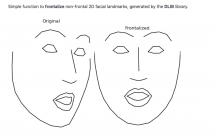
- Read more about Identity-invariant Facial Landmark Frontalization for Facial Expression Analysis
- Log in to post comments
We propose a frontalization technique for 2D facial land- marks, designed to aid in the analysis of facial expressions. It employs a new normalization strategy aiming to minimize identity variations, by displacing groups of facial landmarks to standardized locations. The technique operates directly on 2D landmark coordinates, does not require additional feature extraction and as such is computationally light. It achieves considerable improvement over a reference approach, justifying its use as an efficient preprocessing step for facial expression analysis based on geometric features.
- Categories:
 59 Views
59 Views
- Read more about Automatic Region Selection For Objective Sharpness Assessment of Mobile Device Photos
- 1 comment
- Log in to post comments
Mobile devices are the source of a vast majority of digital photos today. Photos taken by mobile devices generally have fairly good visual quality. When evaluating high-quality mobile device photos, people have to manually zoom in to local regions to discern the subtle difference. Understandably, a global objective quality assessment method cannot perform well on such task. Therefore, local region selection is widely recognized as a prerequisite for the following quality evaluation.
ICIPnow.pdf
- Categories:
 16 Views
16 Views